Related Research Articles

Ragnar Lodbrok, according to legends, was a Viking hero and a Swedish and Danish king.
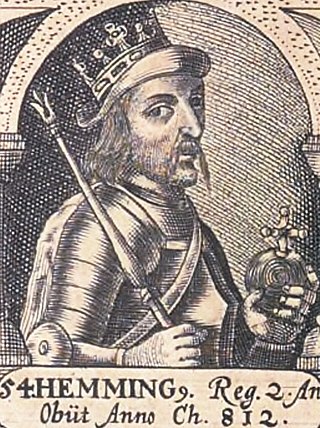
Hemming I was a king in Denmark from 810 until his death. He was the successor of King Gudfred, his uncle.

Gudfred was a ninth century Danish king who reigned from at least 804 to 810. Alternate spellings include Godfred (Danish), Göttrick (German), Gøtrik (Danish), Gudrød (Danish), and Godofredus (Latin). He stands at the threshold of the History of Denmark in the sense that he is the first ruler about whom there is substantial knowledge from contemporary sources. He waged offensive war against the Carolingian Empire with some success, but was murdered under murky circumstances before a major confrontation had taken place. There is no unambiguous trace of Gudfred in the later Norse sagas, and his history can only be traced from the hostile Frankish texts which makes an assessment of his role problematic. His paternity is unknown but he may have been closely related to Sigfred, who preceded him as king of Denmark c. 770–804. He was the uncle of the later Danish King Hemming (810–812) and the father of King Horik I (813–854).
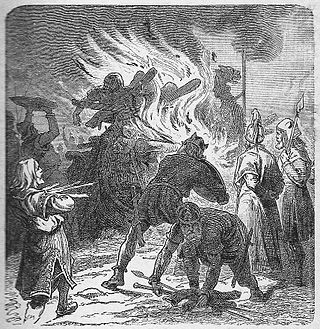
Sigurd Ring according to legend was a king of the Swedes, being mentioned in many old Scandinavian sagas. According to these sources he was granted rulership over Sweden as a vassal king under his uncle Harald Wartooth. Later he would take up arms against his uncle Harald in a bid to overthrow him and take the crown of Denmark, a conflict which Sigurd eventually won after the legendary Battle of the Brávellir, where it is said that Odin himself intervened and killed Harald. In the Sagas, Sigurd is also known for being the father of the Norse Viking hero and legendary king of Denmark and Sweden, Ragnar Lodbrok. According to Bósa saga ok Herrauds, there was once a saga on Sigurd Ring, but this saga is now lost.

Björn Ironside, according to Norse legends, was a Norse Viking chief and Swedish king. According to the 12th- and 13th-century Scandinavian histories, he was the son of notorious Viking king Ragnar Lodbrok and lived in the 9th century, between 855 and 858. Björn Ironside is said to have been the first ruler of the Swedish Munsö dynasty. In the early 18th century, a barrow on the island of Munsö was claimed by antiquarians to be Björn Järnsidas hög or Björn Ironside's barrow.
Eric Anundsson or Eymundsson was a semi-legendary Swedish king who supposedly ruled during the 9th century. The Norse sagas describe him as successful in extending his realm over the Baltic Sea, but unsuccessful in his attempts of westward expansion. There is no near-contemporary evidence for his existence, the sources for his reign dating from the 13th and 14th centuries. These sources, Icelandic sagas, are generally not considered reliable sources for the periods and events they describe.

Sigurd Snake-in-the-eye or Sigurd Ragnarsson/Aslaugsson was a semi-legendary Viking warrior and Danish king active from the mid to late 9th century. According to multiple saga sources and Scandinavian histories from the 12th century and later, he is one of the sons of the legendary Viking Ragnar Lodbrok and Áslaug. His historical prototype might have been the Danish King Sigfred who ruled briefly in the 870s. Norwegian kings' genealogies of the Middle Ages name him as an ancestor of Harald Fairhair and used his mother's supposed ancestry to Völsung in order to create an ancestry between Harald and his descendants and Odin.

Halfdan Ragnarsson was a Viking leader and a commander of the Great Heathen Army which invaded the Anglo-Saxon kingdoms of England, starting in 865.

The petty kingdoms of Norway were the entities from which the later Kingdom of Norway was founded. Before the unification of Norway in 872 and during the period of fragmentation after King Harald Fairhair's death, Norway was divided in several small kingdoms. Some could have been as small as a cluster of villages, and others comprised several of today's counties.
Harald 'Klak' Halfdansson was a king in Jutland around 812–814 and again from 819–827.
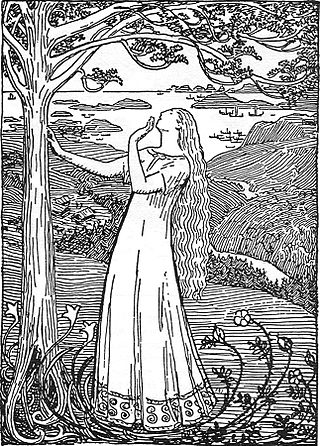
The name Ragnhild Sigurdsdotter may refer to two different figures from Old Norse literature, an amalgam of them, or a purely fictitious figure.
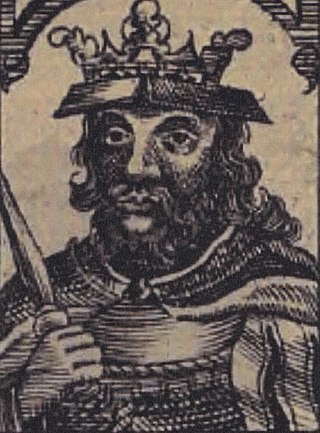
Sigfred was an eighth century Danish king who is known to have reigned from before 777 to after 798. Fragments of his reign can be traced via Frankish sources.

Horik I or Hårik was a king of the Danes. He was co-ruler from 813, and sole king from c. 828 until his violent death in 854. His long and eventful reign was marked by Danish raids on the Carolingian Empire of Louis the Pious, son and successor of Charlemagne.

Horik II, also known as Hårik or, in late sources, Erik Barn, was King of the Danes from the fall of Horik I in 854 to an unknown date between 864 and 873. During his reign the Danish kingdom showed tendencies of breaking up. After his demise under unknown circumstances, Denmark entered a long period of obscurity, until the rise of the Jelling dynasty in the 10th century.
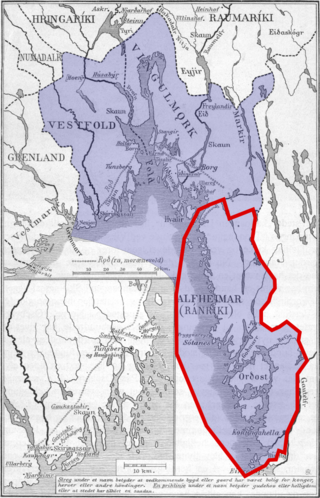
Alfheim is an ancient name for an area corresponding to the modern Swedish province of Bohuslän.
Helge was a Danish king who ruled at the end of the 9th century. There is no contemporary evidence for his existence, since he is only mentioned in a source from the 11th century.

Sigfred was a competitor for the Danish throne in 812. His brief appearance inaugurated a period of throne struggles in Denmark which lasted until 827.
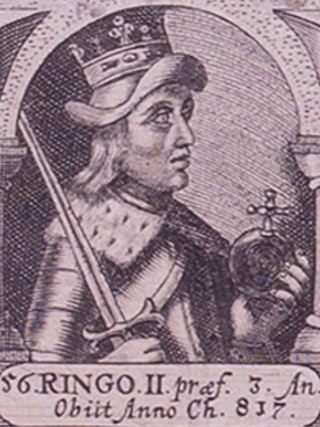
Anulo or Ale was a pretender-king who vied for the Danish throne in 812. He represents the appearance of the House of Harald which competed with the House of Gudfred for power in Denmark until c. 857 and possibly longer.
References
- ↑ Jahrbücher aus dem Kloster Fulda, Anno 873
- ↑ Vilhelm la Cour (1980), "Halvdan", Dansk Biografisk Leksikon, Vol. 5. Copenhagen: Gyldendal, p. 505-6.
- ↑ Rory McTurk, "Kings and kingship in Viking Northumbria",
- ↑ P.A. Munch (1852), Det norske Folks Historie, Vol. I:1. Christiania: Tonsberg, p. 642-8.
- ↑ P.A. Munch (1852), Det norske Folks Historie, Vol. I:1. Christiania: Tonsberg, p. 744.